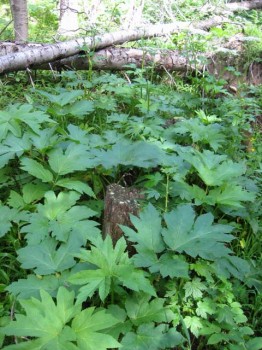
I woke up yesterday morning and cooked my very first quiche, in which the principal ingredient was—you guessed it—cow parsnip! We had it for breakfast; we had the leftovers for dinner; and then we had cow parsnip candy sticks for dessert. For me, there is simply no getting tired of cow parsnip.
I tell my friend Butter that I’m learning to cook through wild edible plants, and not the other way around. She uses fancy cooking words like “duxelle” and “frittata,” meanwhile I’m clutching my head and she has the nerve to say that she eschews recipes. OMG if I didn’t have the recipes I’d be lost! Of course I usually can’t be bothered with measuring cups and most of my “principal ingredients” are not in cookbooks anyway, but a little guidance is always good for discovering, for example, that eggs are important to quiches.
Cow Parsnip Quiche
The quiche-for-breakfast idea came up as I was trying to think of a way to serve Gregg the king bolete (Boletus edulis) that Butter and I found on our first outing together, by the roadside, after searching for them unsuccessfully on foot for several hours. That was also, incidentally, when I gathered all of the wonderful cow parsnip that now fills my refrigerator.
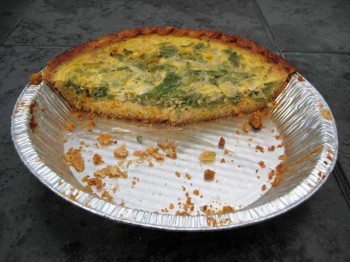
Gregg wouldn’t have the opportunity to eat the fresh bolete for a day and a half after our find. I wanted to prepare it at the earliest possible convenience, however, and that turned out to be breakfast. But what breakfast food could be so delicious as to go with a king bolete, supposedly one of the best mushrooms ever, sought after by mushroom hunters world-wide, known to common folk as porcini? Then the pie crust Gregg’s mom gave us hit me upside the head and the idea for quiche along with it.
Cow parsnip quiche involved painting the pie crust with an egg yolk per the instructions in the Joy of Cooking, in which I first followed the quiche lorraine recipe and then part of the broccoli quiche recipe. I spread 1 cup strong cheddar cheese on the bottom and then poured on the eggy mixture, consisting of 3 eggs (plus the white from the 4th that I didn’t want to throw out), 1 cup milk, ½ cup buttermilk (because I didn’t have cream), 3 cups cow parsnip (after boiling for 5 minutes, straining, and squeezing out some of the liquid), and some chopped onions sautéed in olive oil with garlic until soft. I baked it at 375 degrees for 45 minutes until it set, which probably takes longer here at 11,000 feet than anywhere else in the world.
The quiche—wow—it was awesome! I thought so and so did Gregg.
But heed this warning: If you hope to replicate my results, do not follow the recipe exactly, as it is not to be trusted. Try to tap into your inner hunter-gatherer food sense and deviate intuitively as necessary.
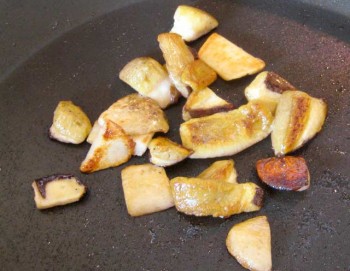
The King of Boletes Taken Down by Worms
Don’t hate me, Butter, but I found the bolete to be less wonderful than the quiche. First, the worms had at the better part of it, and it was all I could do to salvage a few pieces. Then there was some dirt we couldn’t get off that ended up as grit in my teeth. The taste was there—but the experience of eating it, not fully yet.
Gregg’s take on the bolete is much different than mine. “These are delicious!” he exclaimed loudly and repeatedly between savoring each and every piece. He had cooked the small pieces following David Arora’s advice in All That the Rain Promises and More… (1991) that for juicy mushrooms, pan sear dry on high heat first; then when they start to cook in their own juices a little, add butter, lower heat, and sauté. They did look really tasty, as they puffed up and turned golden yellow and brown.
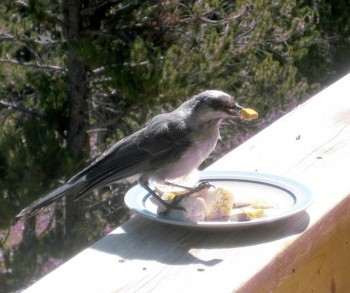
Seriously, though, beating the worms to the mushrooms seems to be an art I will have to master. Meanwhile the search for Boletus edulis continues…
Cow Parsnip Everywhere
The cow parsnip we foraged came from a damp mixed conifer/aspen forest alongside a river down around 7,000 feet in Colorado. I couldn’t believe how plentiful it was! I reached and snipped young leaves and leaf stalks (and an occasional larger leaf stalk for testing purposes) while Butter and I walked and talked for hours of plants and foraging and life.
It ended up being my biggest cow parsnip haul ever, weighing in at 1.75 lbs. Usually, each small batch is such a treasure that I make the same dish every time—boiled cow parsnip served with butter, soy sauce, and chopped raw onions—because neither Gregg nor I can get enough of it prepared that way. But this time there was enough for that and some experimentation to boot. Hence the amazing quiche, not to mention the candy sticks—chewy, sugar-impregnated cow parsnip candy sticks of my dreams.
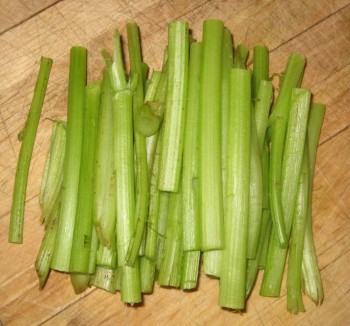
Third Time’s a Charm
It took three tries to be successful with the candy sticks.
Starting out, I made my first-ever candy using the leaf stalks of a different plant—angelica, which I am extremely excited to have discovered, identified, and eaten without expiring but will speak at length of in a subsequent entry—using a recipe for candied angelica from A Naturalist’s Guide to Cooking with Wild Plants (1974) by Connie and Arnold Krockmal. The recipe says to (painstakingly) strip the outer peel off the leaf stalks, boil for 20 minutes, drain, sugar thoroughly, and then cover and let stand for 24 hours. Then you boil down the sugar water until just before it crystallizes (220 degrees Fahrenheit on a candy thermometer, which I don’t have) and pull it off the heat and get it into some glassware quick.
The angelica turned out very tasty, so then I tried the same recipe with the stalks of one of our treasured batches of cow parsnip. It was a sacrifice to the cause because we usually eat the stalks in soy sauce too. This cow parsnip attempt did not go well. First of all, stripping is so tedious. Then I boiled the leaf stalks too long and they got over-mushy. I sat them juicing in sugar overnight per the instructions, only to cook down the sugar water too much, causing crystallization and in fact burning the sugar goo in the middle of the pot’s base. They didn’t even have that infamous cow parsnip taste anymore.
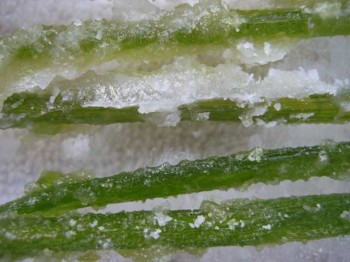
Although even Samuel Thayer says to peel the cow parsnip’s leaf stalks (Nature’s Garden, 2010), for round three of the candy stick experiment, I threw caution to the wind and did not peel the stalks (which ranged from young to slightly older, some thick and some thin) at all, hoping they’d keep their form. I cooked them just until I could easily get a fork through. Later, while boiling off the sugar, I pulled the pot off the stove while the stuff was still slightly goopy, barely a hint of crystallization showing, and put them in glassware quick.
Is it okay to say WOW twice in one entry? The candyfication was exactly what I was looking for—slightly chewy, translucent with sugar, and above all, imbued with that unique cow parsnip flavor. I could eat yards of the stuff!
You see, on round three I was using my hunter-gatherer sugar-stick-making sense—and I’m telling you, it worked!
A Hum-Drum Clarification on Scientific Names
Throughout this site to date I have been using the scientific name Heracleum maximum to identify cow parsnip, member of the Umbelliferae or parsnip family. My identification was based on Brill (1994) and Kershaw et. al. (1998).
Then I read Samuel Thayer’s entry on cow parsnip, Heracleum lanatum, which he puts in the Apiaceae, or carrot family, and nearly shit a brick! I admit I am no botanist, but I aim for not having huge mistakes. Could I have gotten the wrong family?
Compounding matters, Kathryn G. and Andrew L. March (1979), who originally introduced me to cow parsnip with their glowing and rare descriptions of the plant, identify it as Heracleum sphondylium. Not that I don’t understand the fact that different species exist for different genera, but which was mine if not Heracleum maximum? Did I have that wrong too?
Well, it turns out that Apiaceae and Umbelliferae are the same family, and both names are allowed by the International Code of Botanical Nomenclature (ICBN). The family has hollow stems and includes, to name a few: cow parsnip, coriander, cumin, dill, fennel, parsley, normal parsnip, some very poisonous wild plants like water and poison hemlock, and angelica too. Kershaw et. al. further clarify the issue, indicating that H. maximum “has also been called H. lanatum and H. sphondylium.”
In a recent email communication, however, Samuel Thayer indicates that H. sphondylium is the Eurasian cow parsnip, different from the North American H. lanatum or H. maxium, even though some taxonomists have argued that they are conspecific (of or belonging to the same species). “The use of lanatum and maximum is basically the user’s choice, although in moments of doubt I go with R. Voss’s opinion because…well, just because. See, that’s science,” he concludes.
As for me, at least it sounds like I’m okay on the H. maximum/H. lanatum front. (Writer wipes brow in relief that she doesn’t have to go back and change 10,000 entries on cow parsnip using her slow internet, since she seems to write about it like every other week.)
Cow Parsnip Season Still Going Strong
I feel like I’ve grown a lot in the past few months, for after repeatedly panicking that cow parsnip season was over, I’ve discovered that cow parsnip season doesn’t really ever seem to end. Head higher; head lower; think positive thoughts; spend time in the rain—all of these things continue to cause cow parsnip bounty to land in my foraging bag.
And then, after all that, I can take comfort in the fact that when the young leaves are really, truly over for the season, I can go for the seeds and grind them into spice, as Hank Shaw told me recently. Mmm, cow parsnip spice for cooking all winter long. I can only imagine…
NOTE: This post updated 8.19.11 to add Thayer’s clarification on the clarification of scientific names.
WARNING: Per Thayer (2010): “Cow parsnip’s juices contain furanocoumarins, which can cause blistering burns if the juice gets on your skin and is exposed to sunlight.” He also describes a related plant, giant hogweed (H. mantegazzianum), which has become invasive in areas of Ontario, the eastern US, the Pacific Northwest, and elsewhere, that is “extremely dangerous” in terms of its potential to burn the skin and eyes. Thayer thinks it “might” be edible, but readers should regardless exercise caution with H. mantegazzianum, which he describes as having “more deeply cut leaf lobes” and says “can grow to 16 feet in height.”

Gotta say, even if the mushrooms had been pristine, their taste couldn’t compare to the fun we had collecting them.
Agreed:)
I had NO idea that cow parsnip was edible! We live in SE Alaska and it is everywhere. We do our best to avoid it because of the skin reaction… But wow, I’m intrigued now. I’ll have to research to see if ours is the same edible variety. Looks like it?
@Jenny: I checked out your blog. What a life you must have there:) The cow parsnip picture was hard to discern…but I am curious to hear what you find. As you can probably glean from my multiple entries on cow parsnip, I love it. I have heard that some varieties give a stronger skin rash than others.
Nice to see someone else playing with cow parsnip. I like the aroma, but there is a strong bitter back end to the plant that needs to be dealt with. I’ve not yet eaten the leaves, although I don’t see why not (next year), and my method for sugaring the stems is far simpler:
Peel — yes, I am a proponent of peeling — blanch in salty water for 90 seconds to set the color, then roll in granulated sugar. If you really like things sweet, you can boil the pre-blanched stems in syrup for a minute or so, then roll them in sugar. If you do it my way the stems are still crunchy, which I like.
Have you ever messed with the seeds? I’ve found them impossibly bitter.
Oh, and as for wormy boletes, just dry them. The worms flee the mushroom and die. Then you have a perfectly good soup mushroom.
@Hank: Well, we found more boletes, some of which are a little wormy. I sliced them into pieces and they are drying now. True to your word, little worms are fleeing. Thanks for the tip… though for the record, if they were super wormy, we tossed them or used only the caps.
Cow parsnip seeds update: To date I don’t find them bitter, but I’m not altogether fond of the taste–with one exception, and that was some fabulous thin-sliced home-cured pork by the curers of http://www.the365kitchen.com, for which the central seasoning was cow parsnip seeds. Yum!